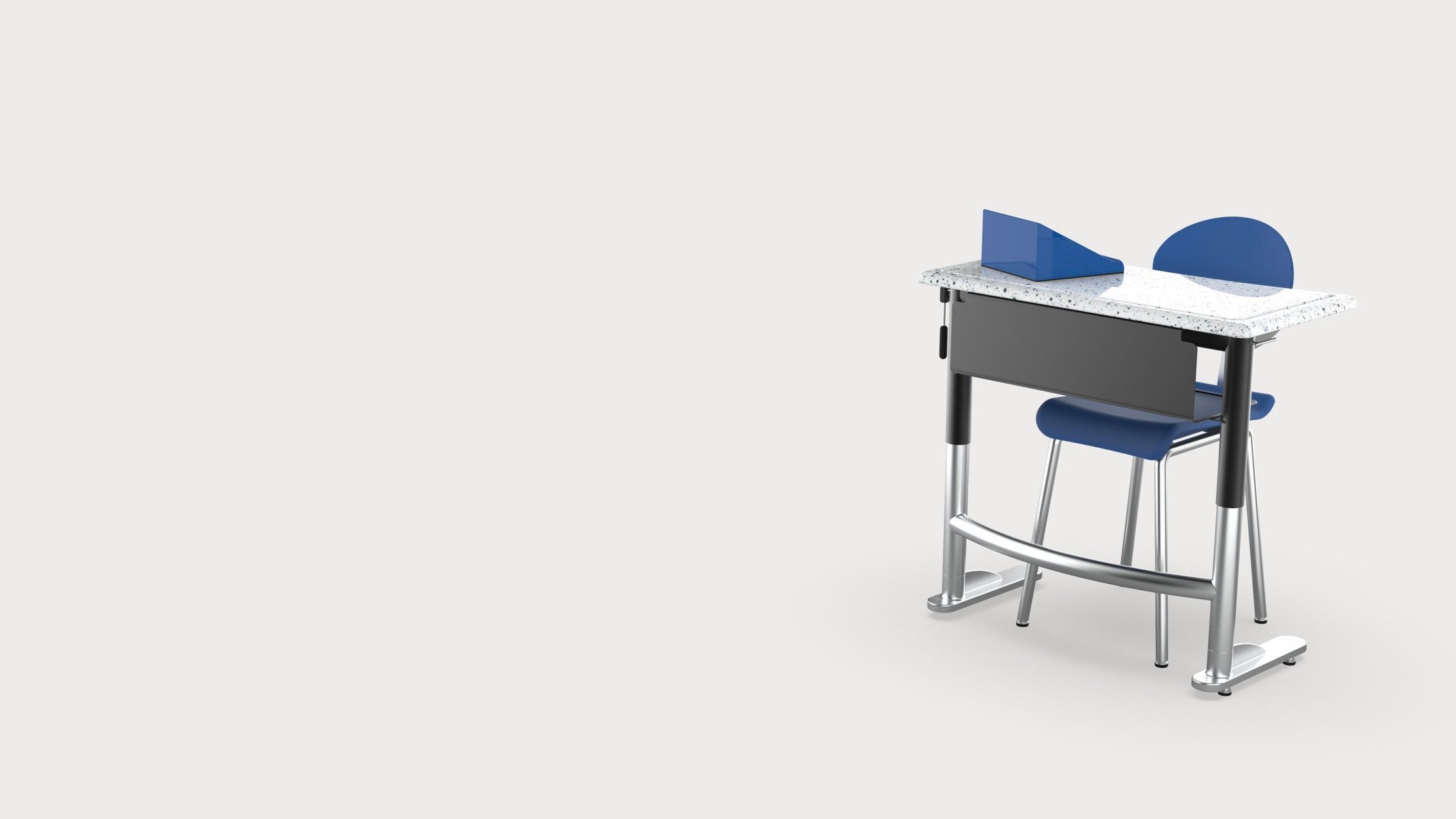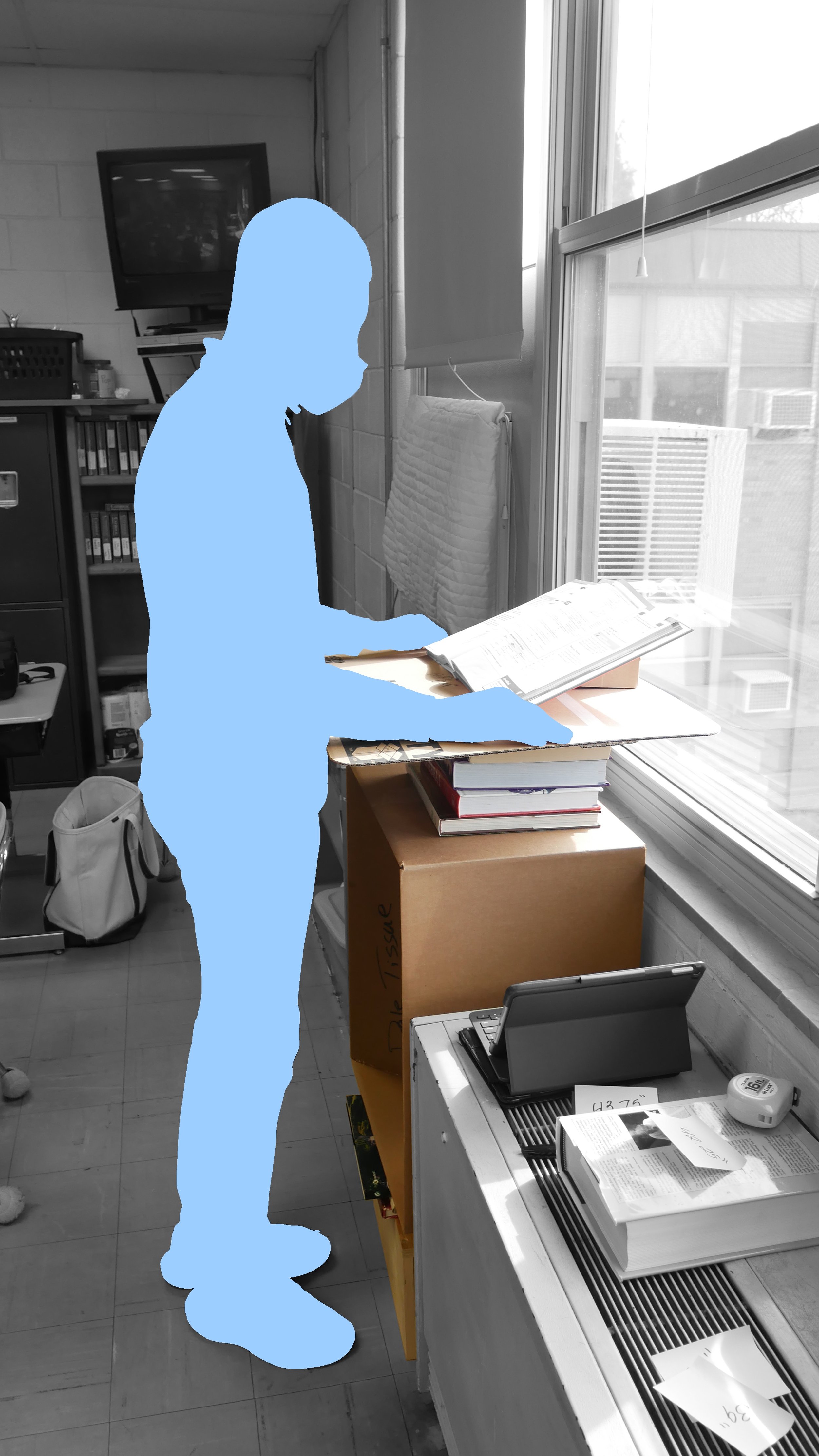
User-Centered Ergonomic
Redesign of School Furniture
Project Guidelines
Complete an Industrial Design Capstone project that integrates the knowledge and skills I have gained and is a culmination of my studies at the College of Design, Architecture, Art, and Planning.
Problem Statement
Redesign the middle school student's desk and chair to enhance ergonomics, allowing for adjustable features that cater to individual needs and promote better posture.
Project Timeline
9-months (or 3 semesters).
Project Discovery
Ergonomic Furniture for Office Workers
Researched traditional office spaces and found that ergonomic solutions existed, and were typically designed to promote healthy working conditions for employees.
Typical Furniture for Middle Schoolers
Based on my experience and research with K-12 environments, I noticed that few ergonomic solutions are used in classrooms. Most furniture for students prioritizes durability over ergonomics.
Idealized Furniture for Middle Schoolers
The few ergonomic furniture options that do exist for students are not easily scalable or practical for most classrooms.
Hypothesized Problem Statement
Middle school students require ergonomic and adaptable desks and chairs to have a more inclusive learning environment.
Industry & User Research
Chair Ergonomics Guidelines
Researched the science of an ergonomic desk and chair setup.
Found how angles, curves, and heights could either negatively or positively affect a person’s comfort while sitting for extended periods of time.
CDC Age Group Heights & Weights
Researched and noted the height & weight ranges for the middle school age group.
Used this data to adjust ergonomic requirements for adults to fit middle school students.
Surveyed Students
Distributed Survey using Google Forms
Distributed a survey to students at two local middle schools and high schools to understand student demographics & classroom needs.
Analyzed Survey Responses
Analyzed survey data from 630 students to identify patterns and pain points.
Survey Results
It was determined, based on the survey results, that the new desk and chair designs needed to focus on increasing students’ comfort while sitting.
With a secondary goal of increasing students’ comfort while reading.
Quotes from Students: What would they change?
“I would make the TABLETOP HIGHER, add an area for storage, and put in edges or grooves to prevent ITEMS FALLING or rolling off of the desk.”
“I would make the DESK LONGER and more COMFORTABLE CHAIRS.”
“If I could change my desk I would make a SOFT EDGING around to so it would be better to write.”
“I would make the DESK LONGER and more COMFORTABLE CHAIRS.”
“More table space, ADJUSTABLE LEGS for height.”
“I would like a STANDING DESK because I’m tired of sitting all day.”
“I would make the DESK LONGER and more COMFORTABLE CHAIRS.”
“More COMFORTABLE CHAIRS.”
“I would make it flat, either ADJUSTABLE or have different sizes, and MORE DESK SPACE.”
“It needs to be lower.”
Observed Middle School Students
Documented key observations through photography:
Chairs are uncomfortable so students sit on their own feet
Writing on the desk causes uncomfortable posture
Desk storage is underutilized, and it impedes student leg room
Students are constantly moving to get comfortable or expel energy
Synthesized Research into Design Goals
Create cost-effective, ergonomic, functional, and scalable work-spaces for students in classrooms.
Key Features:
Chair that ensures proper posture and comfort
Desk top shape that fit today’s materials
Improve reading comfort and posture
Flexible space between chair and desk
Functional storage
Tested & Refined Initial Prototypes
Built cardboard versions of desk, chair, and shelf to assess scale.
Refined the models throughout testing, adding a mobile shelf/wedge and wooden chair with block bottom of various heights.
User Testing of Prototypes
I observed 5 students using rough models to evaluate ergonomics and scale.
Confirmed the wedge enhanced reading comfort.
Feature Sketches
Chair Profiles
Desktop Shapes
Shelf Options
Desk Leg Designs
Evaluating Desktop Shapes
Tested how school supplies fit on 6 full scale, cardboard desktops to determine which shape best accommodates students’ needs.
Developed Scale Models of Designs
Created scale models to refine aspect ratios and structural integrity.
Resulting in a design direction that I then refined in CAD.
Refining Design Features in CAD
Explored how design features refined aesthetics or enhanced functionality.
Explored Adjustable Desk Mechanisms
Considered Electric Standing Desks
I realized a traditional electronic standing desk wouldn't work in most schools due to insufficient outlets at each station.
Investigated Mechanical Crank Option
Explored a mechanical crank mechanism but found it too heavy and cumbersome for common uses in a school setting.
Internal Manual Pneumatic Pump Solution
Determined that an internal manual pneumatic pump could be installed in each leg, allowing students to adjust desk heights by pumping or releasing air pressure.
Internal Manual
Pneumatic Pump
1 - Air Pump
2 - Air Tube
3 - Pressure Tube
4 - Stainless Steel Piston Rod
5 - Piston Packages
6 - Seal
Designer Consultation
Consulted an Industrial Designer at Campus Outfitters on materials and manufacturing process, which helped refine the design into a realistic concept.
Built A Functional Full Scale Model
Built a full scale model of desk and chair designs for user feedback and refinement.
A peg and hole system on the desk’s legs enabled height adjustments.
User Feedback on Full Scale Model
User testing identified several areas for improvement:
Shelf is too low and hits the student’s knees
The height of the chair’s backrest needed adjustment
Horizontal support between the legs of the desk needed to be curved
Finalizing Design
Desk Design
Handle to Raise the Desk
Handle to Lower the Desk
Half Shelf for Wedge Storage
Non-Marring Glides for Feet
Speckled Melamine Desktop
Channel for Pens & Pencils
Chair Design
Chair Back - G.A.I.M Molding
Ergonomic Seat
14 Gauge Bent Steel Tubing Legs
Non-Marring Glides for Feet
Spring Steel Spine
Project Take Aways
Expanded research abilities.
Practiced developing product solutions from user insights.
Used human factors to guide design direction.
Final In-Context Render

Previous Project
Gwyn Kavalew’s Porfolio
Next Project















































